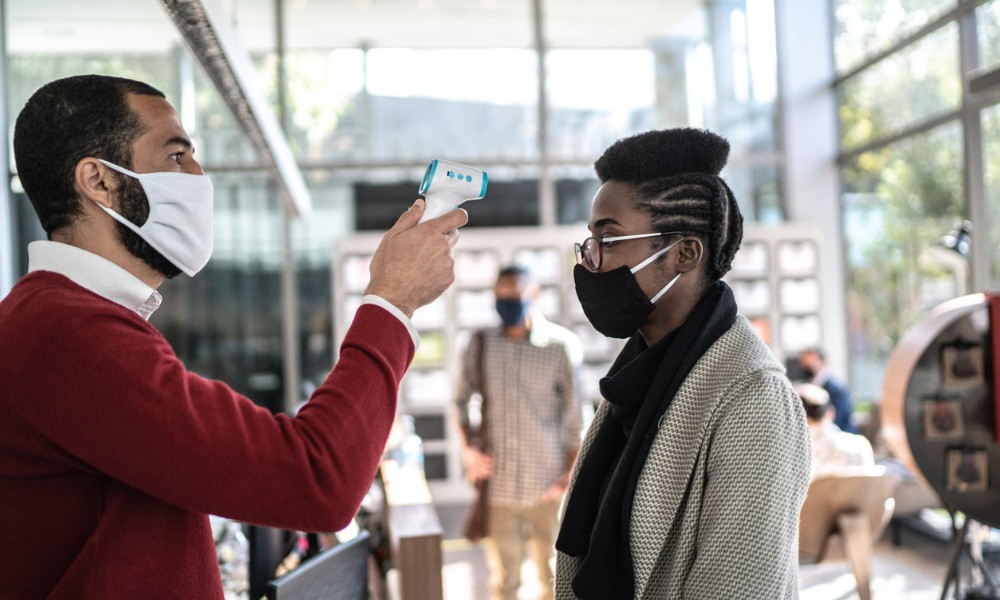‘If you’ve got an employee who refuses to participate, then you’re well within your rights to say, ‘You can’t come to work today’’

On June 30, new rules were implemented in Ontario regarding workplace screening. To find out about what’s changed, and how employers should respond, Canadian HR Reporter spoke with Michael Sherrard, founding partner of Sherrard Kuzz in Toronto.
“There are a couple of exceptions but, for the most part, all the businesses that are able to be open should be amending their screening questions accordingly.”
Q: What’s involved with the new screening rules?
A: “They made updates that relate to whether or not somebody has a vaccination or is fully vaccinated. They’ve said a worker can now answer no if the worker is experiencing any of the listed symptoms… headaches, muscle aches, joint pain or fatigue -- they can still answer no to the screening question, so long as the worker was vaccinated within the previous 48 hours, and began experiencing those symptoms only after the vaccination.
“The next one is they say a worker can also answer no if the worker lives with someone experiencing COVID-19 symptoms, or is waiting for test results after experiencing symptoms, so long as the worker is fully vaccinated and has not been advised to self-isolate by public health.
The third one where the worker can now answer no as well is if the worker lives with someone who is experiencing, and they list, mild headaches, fatigue, muscle aches and or joint pain, so long as symptoms began after vaccination and regardless of the vaccination status of the worker.
[Also] there’s a new question now that says, ‘In the last 10 days, have you tested positive on a rapid antigen test or a home-based self-testing kit?’ The final one is with respect to travel outside of Canada and that question now reads, ‘In the last 14 days, have you travelled outside of Canada, and been advised to quarantine per the federal quarantine requirements?’ Our interpretation is that this change reflects the new exemption to the 14-day quarantine requirement that applies to most fully vaccinated Canadian travellers.”
“The screening tool itself is not applicable to healthcare settings. For example, long-term care homes; in some of the non-healthcare workplaces, retirement homes and other congregate living settings, like schools and childcare.”
Q: How should employers changes screening and vaccination rules?
A: “The first thing is to amend your screening tool, certainly that’s your immediate task. For many employers, the next task also may be to put in place a policy as it relates to vaccination because while the screening tool is now impacted, the vaccination status of workers will now start to be a significant issue in the workplace as many employers are able to return to greater levels of employment. Greater levels of employment will be impacted by the percentage that each employer’s workers who have been vaccinated.
“The employer wants to set clear expectations and one of the best ways of doing that is creating a policy as it relates to your view of what workers should do as it relates to vaccinations, giving them lots of advance notice of your requirements.
“For example, if an employer said, ‘We’re going to require vaccinations as a requirement of return to the workplace,’ they want to have a policy. In that policy, they want to illustrate the reasons as to why they’re requiring that, provide them with advance notice [and] also provide a section that talks about exemptions. If somebody has a human rights-based rationale for not getting a vaccination, you will want to put that in your policy.
 Michael Sherrard
Michael Sherrard
“If you happen to be unionized, then you want to engage with your union partners as well because putting in any kind of new policy — and there’s a process that you want to follow — to ensure that it’s consistent with the collective agreement, it’s seen to be reasonable and certainly you’ve also provided people with sufficient advance notice of your expectations.”
Q: What should an employer do when a worker refuses to be screened?
A: “Provided they’ve got a policy, what I’ve seen the majority of employers do if somebody refuses to go through the screen [is say] that they’re not permitted to come to work. You start by asking the worker why, so you understand the basis for the denial to participate in the screen, but every employer has a health and safety obligation to take every precaution reasonable in the circumstances.
“In our circumstances right now, a pandemic is still with us; public health has made it really clear that this screening tool is something that employers need to do and if you’ve got an employee who refuses to participate, then you’re well within your rights to say, ‘You can’t come to work today.’”
Q: What happens if an employee tests positive?
A: “The rapid antigen testing, as one example, has helped employers and, frankly, helped employees and certainly the results [have meant] a reduced spread of the pandemic in workplaces. If somebody was to test positive, the next step is the employee is not allowed to attend work and the employee is then directed to Public Health to go and take a PCR test. The PCR test is the test that Public Health has been relying upon in terms of whether or not somebody has COVID or not.”
Q: How important is proper and thorough record-keeping?
A: “It’s very important to keep your records. We use a simple app to make it easy for each of our workers to fill that that screening test, most of the time before they even come on site. It’s really, really important that you keep all that information because that will help in the event that you ever actually have a positive case within your workforce [and] to help Public Health with contact tracing.”
Canadian HR Reporter has also spoken with experts about six important questions about rapid testing and looked at some of the ways to manage work-from-home arrangements, from a legal perspective.




